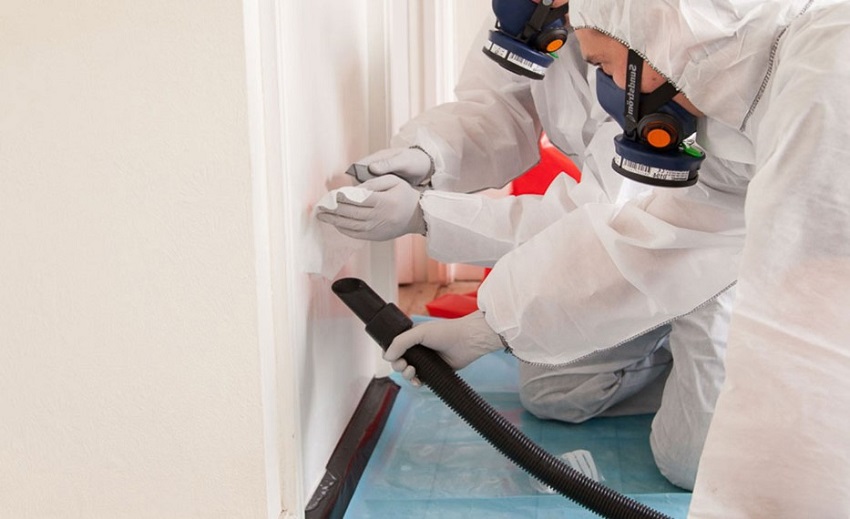Even though asbestos is illegal in many countries, it can still be found in older homes and buildings. Before you can begin the process of having the asbestos removed from your home or building, it is essential to work with a reputable environmental consulting firm to identify asbestos in building materials.
Important Steps in Asbestos Removal
-
Asbestos Consulting
Getting an asbestos inspection or indoor air quality testing from a qualified and licensed asbestos consultant is the first step in asbestos removal. A qualified environmental consulting company will examine the structure, and samples of any components that might be thought to contain asbestos will be taken. These samples will next be examined by an authorized laboratory to see if they contain asbestos. The consulting company will devise a strategy for its secure removal once the presence of asbestos has been confirmed.
Hiring a skilled asbestos occupational hygienist is essential before starting the asbestos removal process. First and foremost, asbestos removal is a challenging process that requires qualified staff, specialized equipment, and training. The most crucial thing is to pay great attention to the location and manner of asbestos removal because errors can occur quickly. Because only experienced and licensed specialists have the requisite knowledge and experience, asbestos consulting is crucial for everyone who wants to remove asbestos safely without exposing themselves or others to dangerous fibers.
-
Controlled by Dependable Firm
Second, asbestos evacuation is controlled by the public authority, and the inability to follow guidelines can bring about fines and punishments to the proprietors or individuals connecting with an asbestos removals to embrace a task. A qualified environmental asbestos consulting firm will have the knowledge and expertise required to negotiate the restrictions and guarantee that the removal procedure is carried out in compliance with all local, state, and federal laws.
-
Get Point by Point Report
Third, an expert word-related hygienist firm will want to give a point-by-point report of the asbestos expulsion process and give a freedom confirmation of the property after asbestos evacuation is finished. Knowing that the property is secure for habitation will provide the owner or potential buyer’s peace of mind.
In conclusion, asbestos removal or indoor air quality testing is a significant undertaking that should not be undertaken lightly. Before beginning the removal process, it is essential to hire a licensed asbestos consultant and a professional occupational hygienist if you have any suspicions that your home or building may contain asbestos. Only qualified specialists have the expertise and abilities required to remove asbestos safely without exposing themselves or others to dangerous fibers. A qualified occupational hygienist will be able to navigate the rules and provide a thorough report and asbestos clearance certificate after asbestos removal is complete, giving you peace of mind.
The Cycle of Asbestos Review
Asbestos is a characteristic mineral silicate that was broadly utilized by the development business because of its solidness, fire/heat obstruction, and waterproofing properties. Notwithstanding, because of the disclosure of the unfriendly impacts of asbestos on human well-being, the utilization of asbestos in the development business has been restricted. Asbestos testing or indoor air quality testing has become standard practice in the industry as a result of the increasing number of old building structures being renovated or demolished throughout the world. During the asbestos inspection survey and sample collection, asbestos consultants/occupational hygienists must adhere to strict guidelines for safe asbestos testing.
A licensed asbestos professional inspects the building materials whenever they are accessible to identify the Asbestos Containing Material (ACM) and its type—bonded or friable—during the inspection survey.
-
Before Test Assortment
After the ID of the ACM during the investigation study, the asbestos expert/word-related hygienist should make essential well-being arrangements for examination. This includes limiting admittance to the testing area for others, advance notice signs or blockades are commonly utilized. Coveralls and Personal Protective Equipment (PPE), including Respiratory Protective Equipment (RPE), are required for the professional conducting the sampling. Before sampling, it is necessary to turn off any appliances or equipment, like fans or blowers, that could help spread the asbestos fibers in the sampling area. To prevent the subject area from being cross-contaminated, drop sheets must be used to collect any unnecessary dust that is released during the sample collection.
-
During Sample Collection
To prevent fiber release during sample collection, the sampling location on the material must be wetted with wet wipes or spray bottles. Delegate tests are gathered utilizing hand instruments like an etch or center drill. When collecting asbestos samples, no power tools should be used because they can produce and spread a lot of asbestos fibers nearby. A tiny sample, about the size of a fingernail, will be taken and put in a zip-lock bag. To ensure the sample’s safety during transportation and handling, it must be double-bagged.
Seal the sampling point with paint, glue, or duct tape following sample collection to prevent further fiber release. Clean the tools that were used. Remove the drop sheets with care to ensure that no fibers or dust remain in the area. Duct tape should be used to seal an asbestos disposal bag containing the drop sheets and PPE coveralls. All asbestos squander should be arranged in an approved asbestos removal site.
-
Labeling the Sample Bags
Label the sample bags with a unique identification number during transportation. Ensure the external surface of the sacks is liberated from any residue or strands for the security of the individual taking care of the examples. Take the Chain of Custody (COC) document and the samples to an accredited laboratory for asbestos testing.
Testing an accredited laboratory conducts asbestos testing, which involves analyzing materials to determine whether or not they contain asbestos. To the 2017 WHS Regulation, all asbestos testing is performed by an accredited laboratory for conformation analysis using stereo microscopy, polarized light microscopy (PLM), and dispersion staining techniques. During the laboratory testing, the type of asbestos and its presence are determined.
